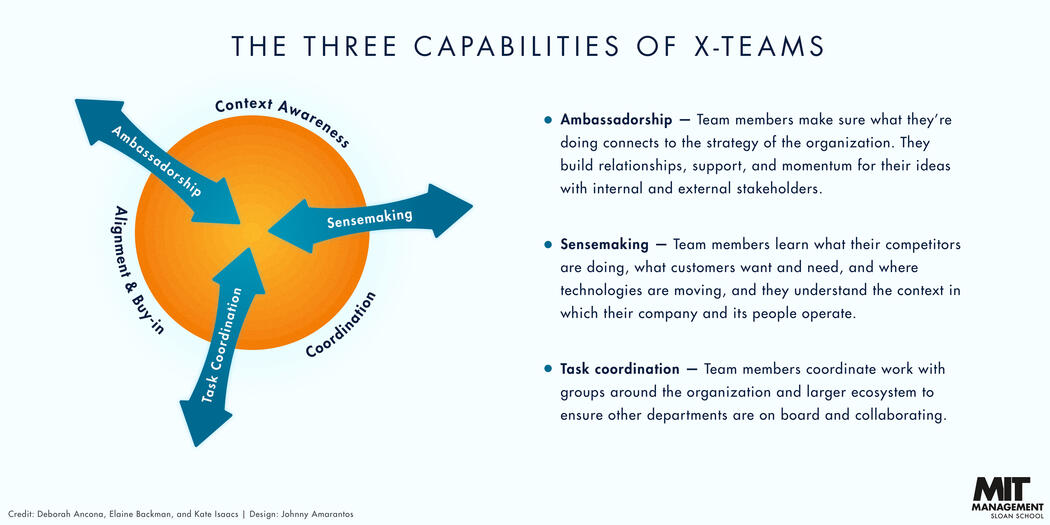Credit: Mimi Phan / Sasin Paraksa / Shutterstock
The world is changing exponentially; to keep up, organizations must rely on their teams to connect with and make sense of their environments and innovate quickly.
But the traditional model, whereby teams focus on internal processes, roles, and goals, is no longer enough, according to MIT Sloan leadership professor The model that organizations need now is an x-team.
X-teams are built on the concept of “out before in,” Ancona said, with team members externally oriented to learn and discover what’s happening in their world through ambassadorship, sensemaking, and task coordination.
“They combine innovation in early phases with execution and create an infrastructure of innovation for the entire organization,” said Ancona during a recent MIT Sloan Management Review webinar.
Ancona is the founder of the MIT Leadership Center, and her research focus includes teams and distributed leadership. She is also the co-author of “X-Teams: How to Build Teams That Lead, Innovate, and Succeed,” along with Henrik Bresman. A revised and updated version was published in early August 2023.
In the webinar, Ancona highlighted how leaders can start x-teams in their organizations, engage employees, and manage innovation up and down the organization.
It doesn’t matter where you use x-teams, just start using them
While there’s no limit to the size of an x-team, Ancona said they operate best in tiers:
- A core of about five people who manage the team and make decisions on next steps.
- Operational members who perform a particular task or conduct sensemaking or task coordination.
- Outer members who join the team for a short period of time to lend their expertise to a project.
This tiered organization ensures that an x-team can grow when necessary but isn’t overwhelmed with too many full-time members to actually get anything done.
Because innovation is needed in nearly every functional area and every kind of work today, x-teams can be applied anywhere in an organization. The key is to get the ball rolling and build momentum through successes and lessons learned. These new behaviors can then spread through the organization, creating a more nimble, connected culture and mode of operation.
“It doesn’t have to be something absolutely new; it can be fine-tuning what you’re [already] doing,” Ancona said. “I would use an x-team when there’s a real need to better keep up with external shifts, learn from others, and better understand your customers and technologies.”
What x-teams do is important, but so is when they do it. If there is a lot of change going on, x-teams should respond with a “pulsing” of attention and effort, depending on when they are needed in the innovation process.
“You might focus first outside to learn, then inside to process, and oscillate from there,” Ancona said. “Similarly, the team might meet together to create identity and culture and then separate, or move from planning to doing to reflecting and back again.”
Gain employee buy-in through education and a step-by-step approach
Once an organization decides to implement x-teams, leaders should begin to educate the workforce about the shift in approach to how work gets done, Ancona said.
Related Articles
Pharmaceutical company Takeda, for example, embedded x-teams into its research and development centers to learn about changes in the industry, Ancona said. The company also provided coaching for the teams to help them learn to reach outside Takeda’s boundaries to process what they learned and to partner with other companies to speed innovation.
“Part of this also requires a shifting organizational context, where we don’t blame people or punish people for reaching out across boundaries and sometimes getting it right and sometimes not so much,” Ancona said.
As x-teams get off the ground, have members share stories about what worked and what didn’t, the skills they developed, and how they’re now able to think and do things differently.
“Those stories help to power other people in the organization,” Ancona said.
To avoid overwhelming employees, make step-by-step changes. For example, if the organization wants to know more about its customers, start with a goal for x-team members to interview one customer per week. Allocate work to team members with clear goals, such as mapping the competitive space and finding out what the competitors are doing in the market.
Consider bringing in outside experts to brainstorm with the x-team, and then capture what’s learned and communicate it to others, Ancona said.
Set guardrails to manage innovation
To maintain some control over innovation and avoid chaos, use a funneling system to choose among the new ideas generated from x-teams.
“One of the key things to talk about is the idea that you’re going to come up with lots of ideas [and] not all of them will be good,” Ancona said.
A funneling system can help narrow down those ideas to ones that actually make it into practice. Southwest Airlines uses a “choice committee” to decide on those ideas, while Takeda’s R&D centers have contests for the best new innovations.
“The winners are the ones that progress into things that the organization actually does or implements — maybe across the entire company or unit,” Ancona said.
She cited the simple rules developed by MIT Sloan’s and Stanford’s Kathleen M. Eisenhardt as another way to channel innovation. For example, if there are too many teams working on small engineering projects, set the rule that the organization won’t fund a product unless it’s going to make a certain amount of money in the marketplace. And establish collective quality control, which empowers teams and individuals to say “time out” if they are worried about not being able to implement something or feel that they’re going in the wrong direction.
These guardrails, Ancona said, “help people who are anxious to know that the x-team work is going to be directed in a way that helps organizations to be better at what they do, and to innovate more.”




